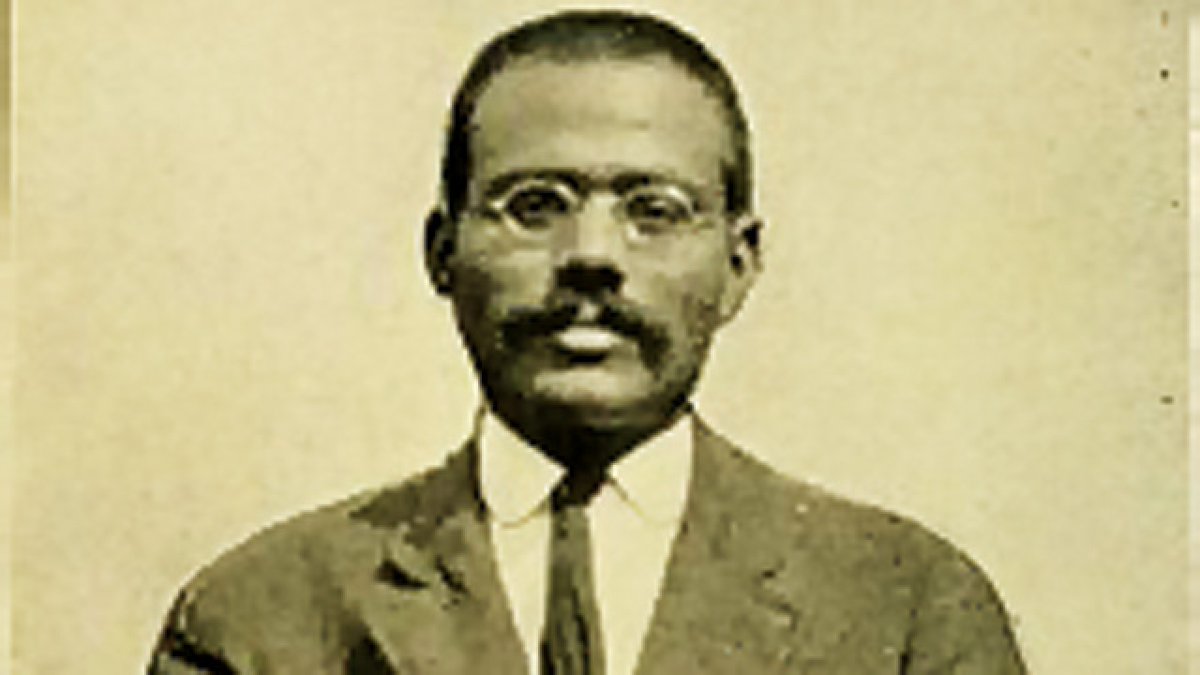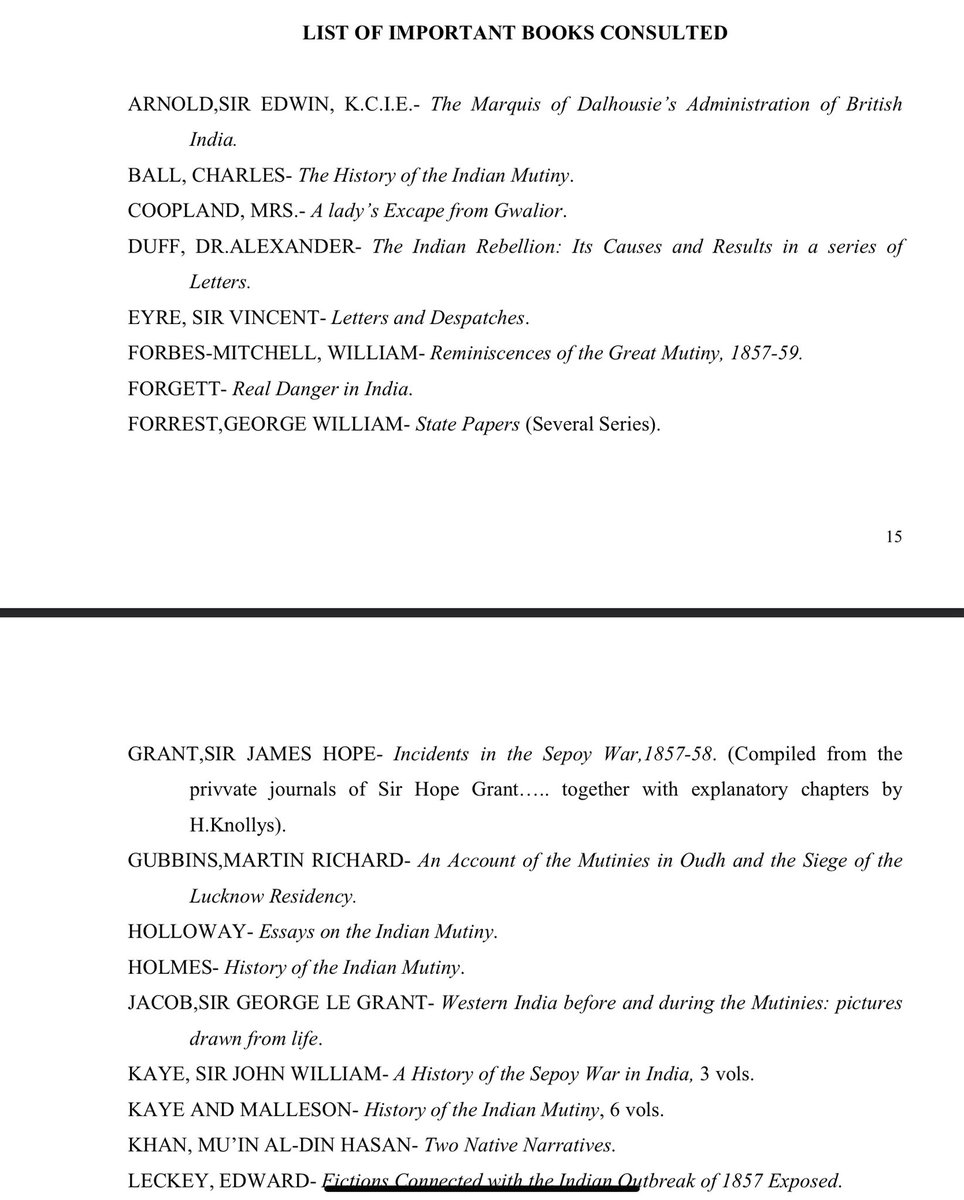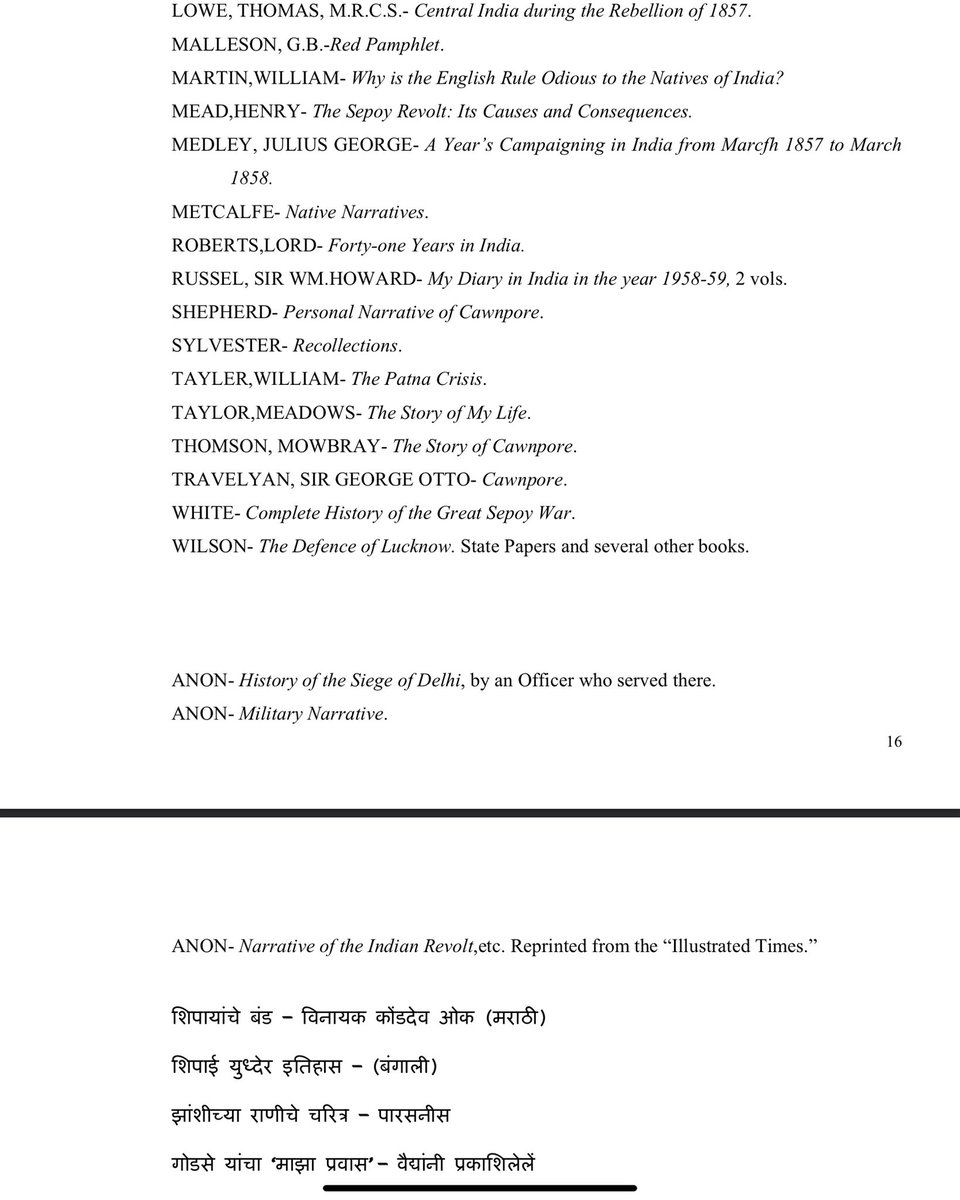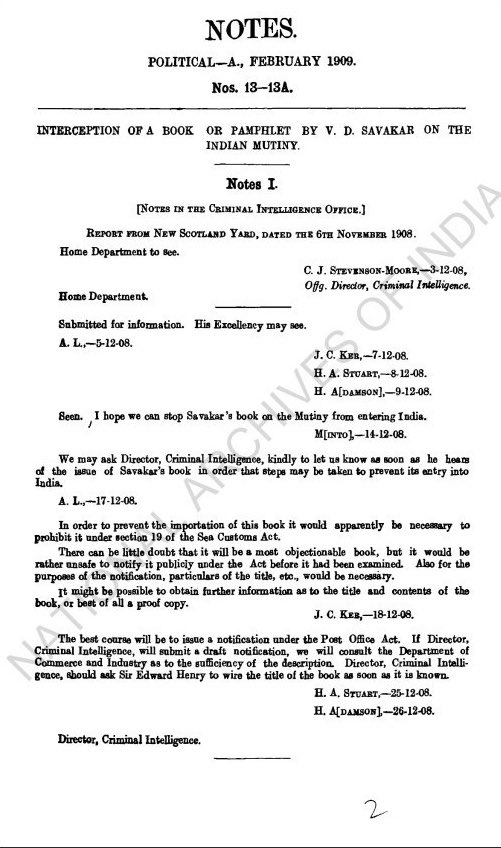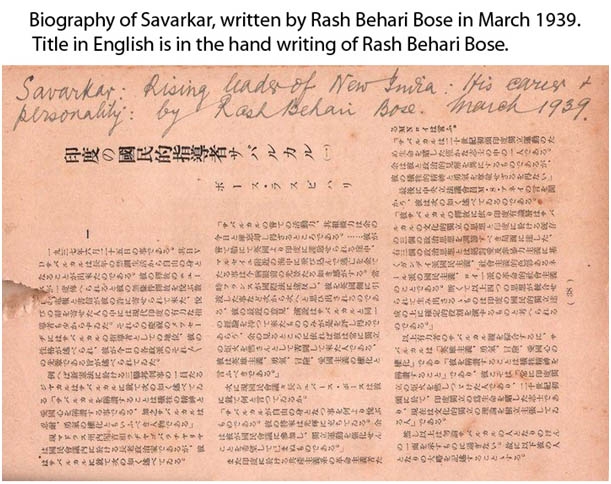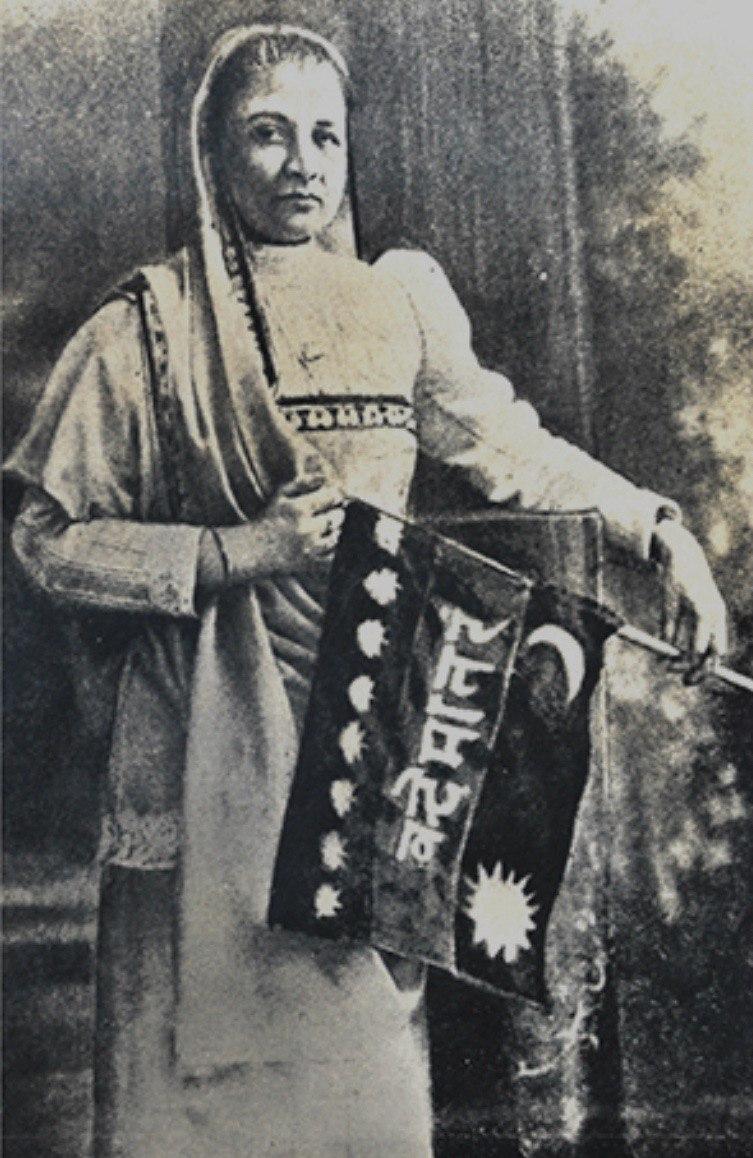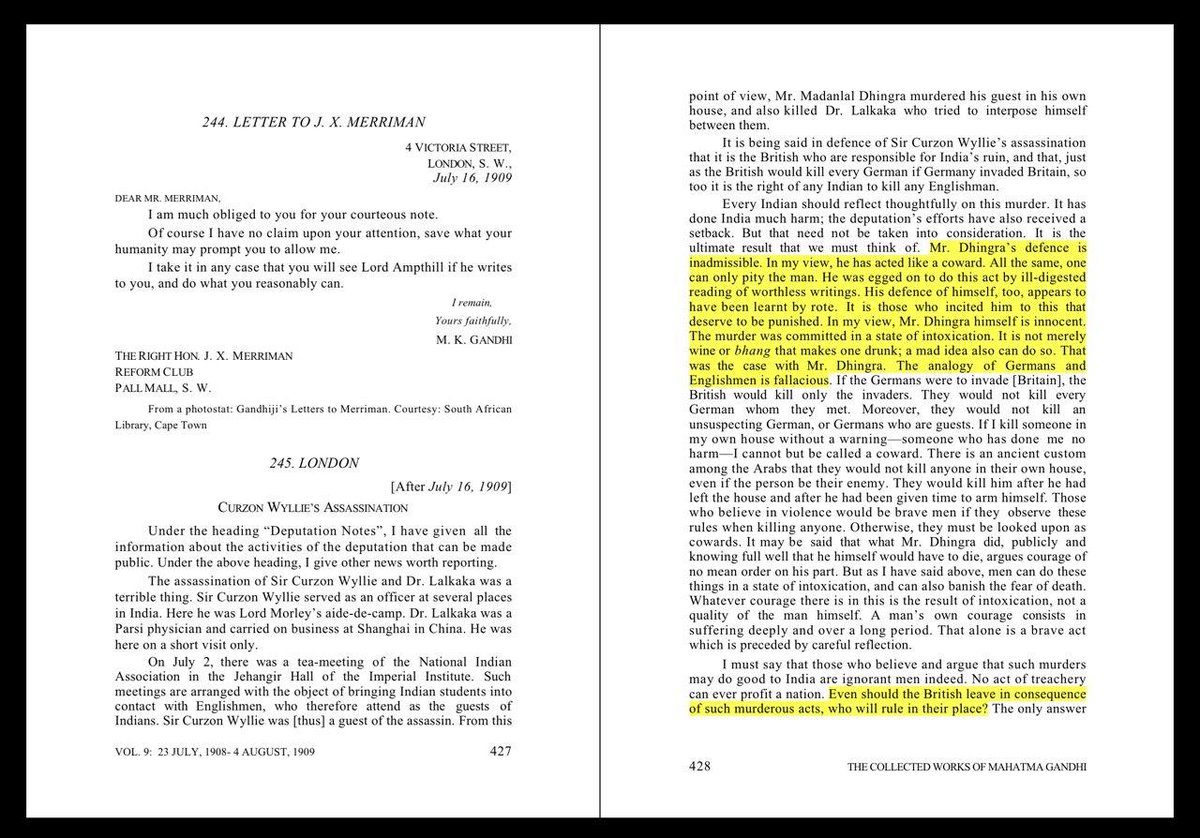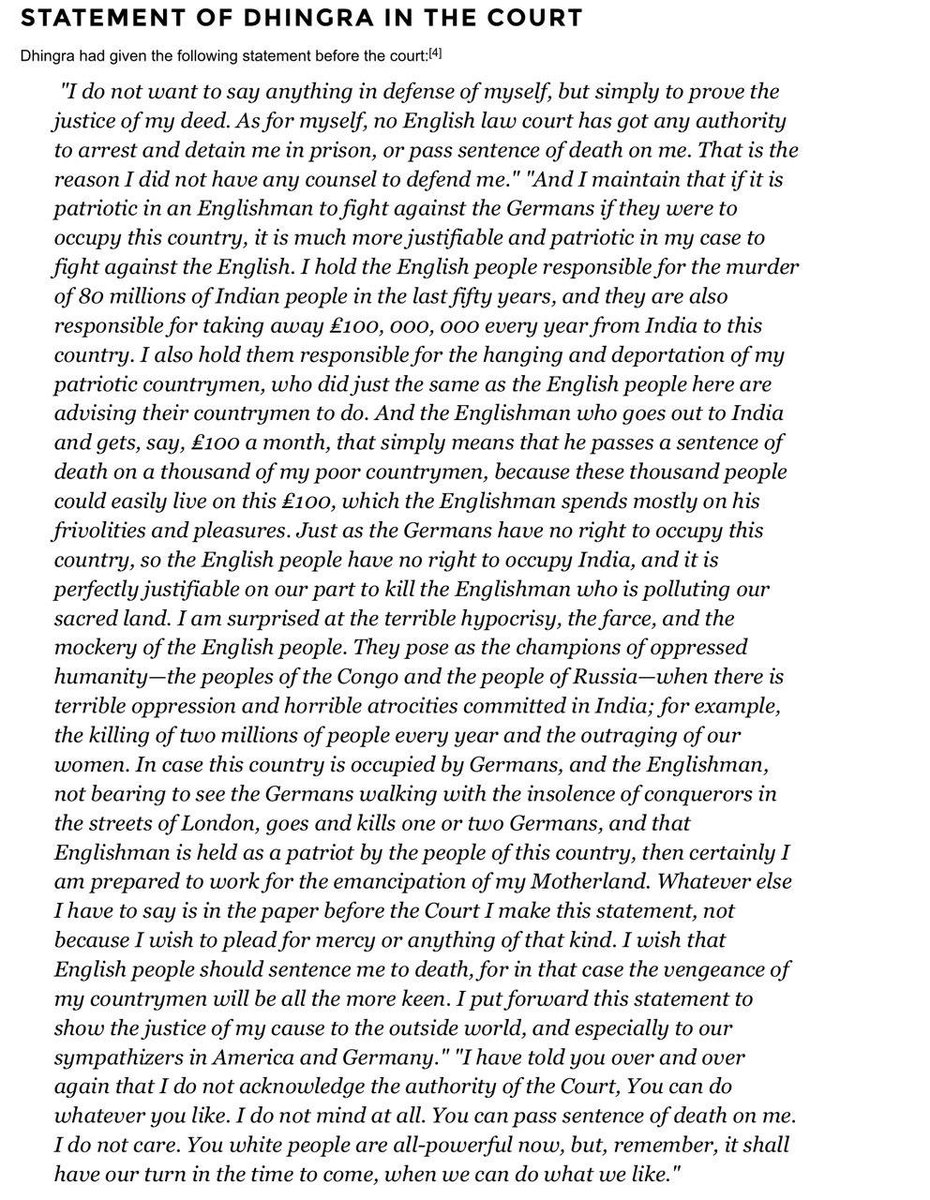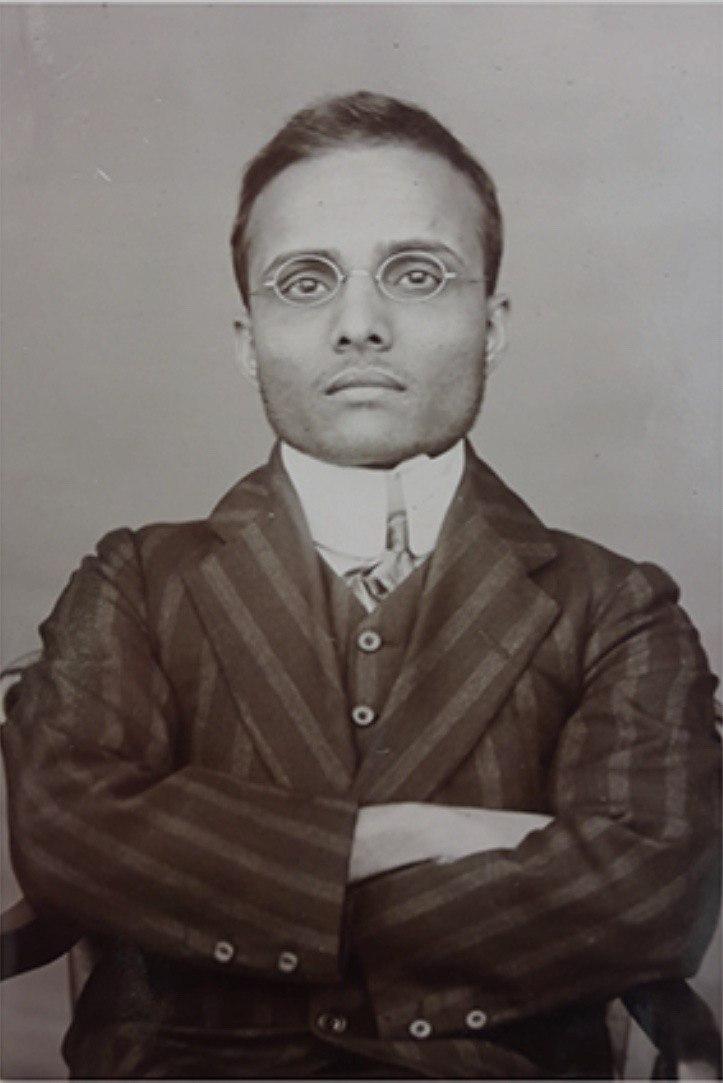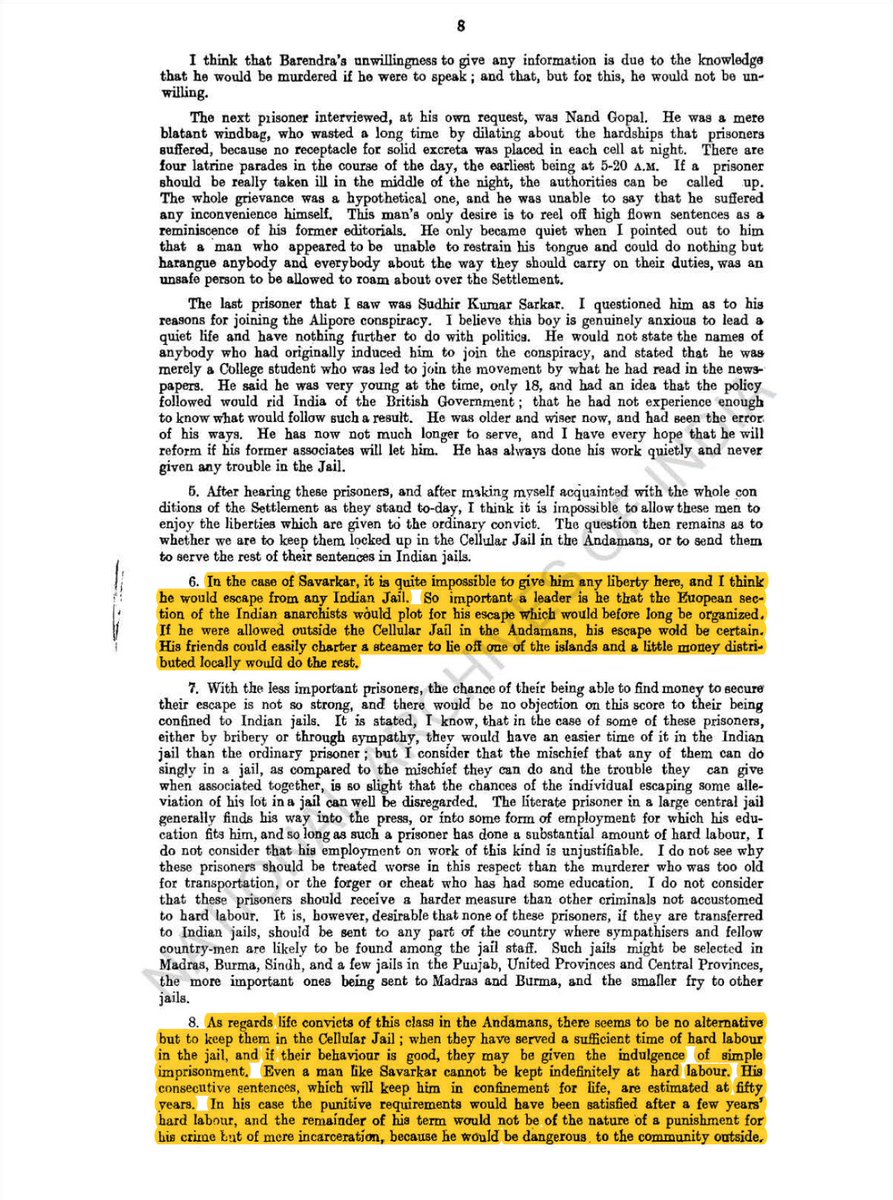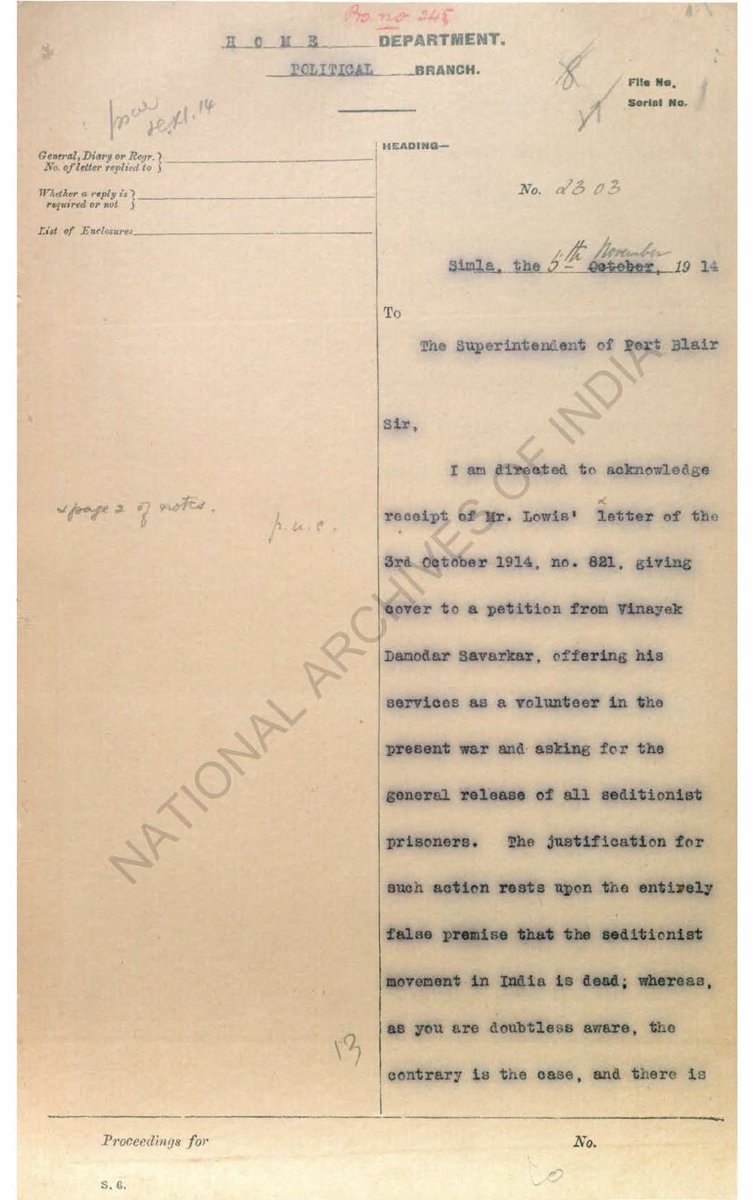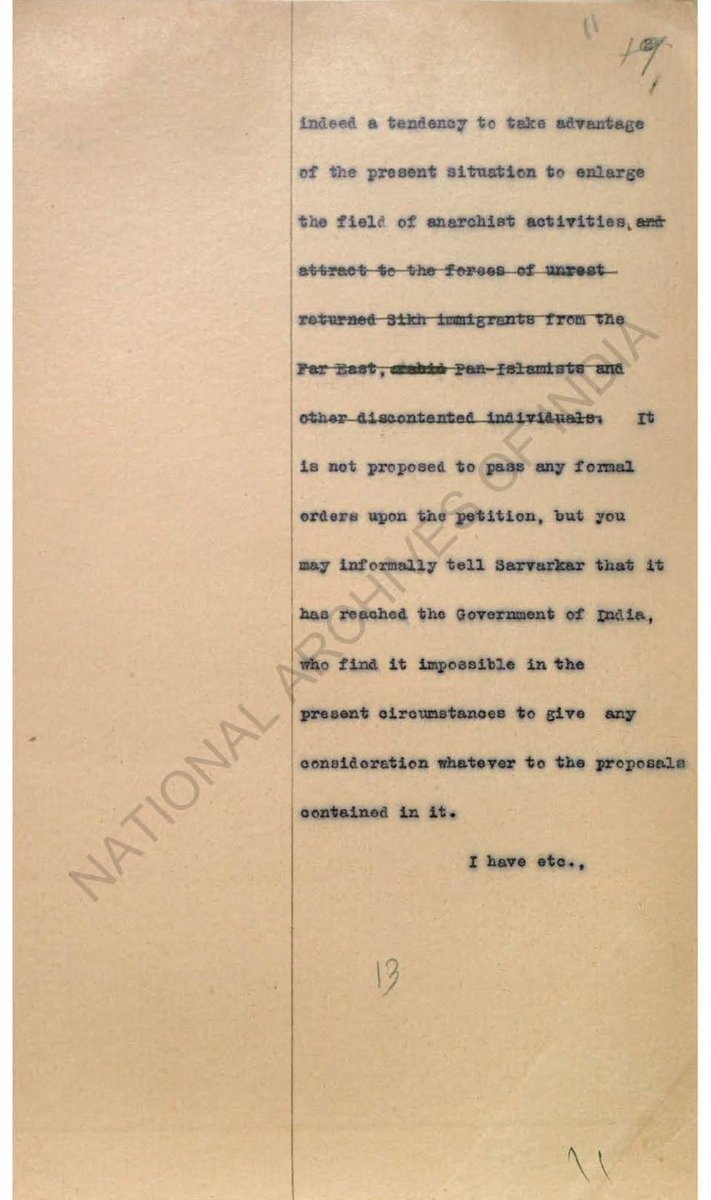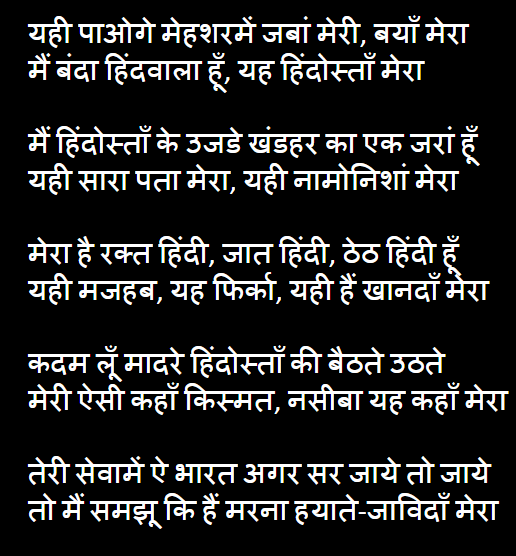A lot of my educated friends from other side of the political spectrum have started dissing Vinayak Damodar Savarkar, a freedom fighter, taking cue from their leader Rahul Gandhi. This mindless vilification of a man who spent his life in service of the nation makes me furious!
2. This thread is to urge all of you to read about Veer Savarkar. I will begin to highlight the key aspects of his life which people miss in this tirade of abuse and offensive memes which just portrays him as a person who & #39;apologized& #39; to British. And I will come to that as well.
3. This thread has close to 90 odd tweets. For those of you who do not have the patience to read the entire thread, here are the points - Savarkar’s formative years - tweets 4 to 14. Revolutionary activity in London - 15 to 47. Kala Pani & ‘Mercy’ Petitions - 48 onwards.
4. Even as a 17 year old, Vinayak wanted independence. He set up an organisation called Mitra Mela as a front-end organisation of Rashtrabhakta Samuha on 01/01/1900 with the objective to organise and prepare for armed revolution while maintaining a facade of cultural activities.
5 Shivaji festival was celebrated in Maharashtra in a tepid way. Mitra Mela took up the task to celebrate it in a grand way. During this occasion, Vinayak delivered a rousing speech. Soon it was followed by Ganpati festival where he coined the slogan & #39;Swatantrya Lakshmi ki Jai!"
6. Vinayak had always been a voracious reader and during this time he also started writing extensively. He wrote a beautiful poem in praise of the Godavari - Godavikili. A lot of theatre artists reached out to him and requested him to write, which he did.
7. He also studied Kalidas, Milton, Shakespeare and compared Ramayan and Iliad in an essay. One of these articles was on Nana Fadnavis and why we should celebrate national heroes. This essay was prescribed by Bombay university for matriculation syllabus in the 1940s.
8. His heart wrenching poem, "Vidhawanchi Dukhe" talked about the plight of Hindu widows and dealt with cruel customs they had to face. This won him a prize of Rs. 20 and showcases his progressive outlook of social reform especially with respect to women’s rights.
9. Pune had become the hub of political activity in India. In 1903, his poem & #39;Jayostute& #39; created a huge impact among masses. It was later composed by Hridayanath Mageshkar and sung by Lata Mangeshkar and broadcasted on AIR after independence.
10. Vinayak and his fellow revolutionaries weren’t some misguided fools to take on a mighty British empire without a plan. In Pune, he came in contact with Lokmanya Tilak. When British partitioned Bengal in 1905, it was Vinayak& #39;s idea to organise a bonfire of foreign clothes.
11. The plan was executed on Dushara. On the same day in Nashik, his elder brother Ganesh organized a similar bonfire at Race Course Grounds. This was a moment of solidarity in the national movement where people across the nation were standing with the plight of people in Bengal.
12. Due to leading the movement of burning clothes, Vinayak was expelled from Ferguson college hostel and fined Rs.10. S.M. Pranjpe organised a meeting in Sarvajanik Sabha where eminent Punekars spoke in favor of Vinayak. Tilak wrote a stinging editorial "These are not our Gurus"
13. By now Mitra Mela was renamed & #39;Abhinav Bharat& #39;. They started contacting revolutionaries to make a network throughout India. Ganesh Savarkar met Aurobindo Ghosh and his brother Barindra at Surat in 1907. After that they were in constant contact with revolutionaries from Bengal
14. A secret file was first opened on Savarkar brothers in 1906. Their public meetings were regularly attended by Police detectives and they knew it. However, one mole had gained access to the inner circles who would later testify against him.
15. In London a new chapter of his life opened. He started lodging at & #39;India House& #39; created by Shyamji and quickly made it the epicenter of Indian revolutionary activity right inside the enemy& #39;s heart.
16. Benefits of going to London were multiple.
-He would become a barrister.
- A large scale propaganda could be carried out to draw eminent Europeans towards their side.
- Learning how to manufacture cheap bombs.
- Creating an international network of revolutionaries.
-He would become a barrister.
- A large scale propaganda could be carried out to draw eminent Europeans towards their side.
- Learning how to manufacture cheap bombs.
- Creating an international network of revolutionaries.
17. In London, Vinayak came in contact with a lot of great men and women. One of them was Lala Hardayal who joined Abhinav Bharat. Both of them were stars of India House. The same Lala Hardayal later founded Ghadr party and galvanized Indians across America & Canada for freedom.
18. Then there was Madam Bhikaji Cama. & #39;Mother of Indian revolutionaries& #39;, Madam Cama, as per British, "was regarded by Hindus as a reincarnation of some deity, presumably, Kali& #39;. Initially a moderate, she soon was swayed by the revolutionary cause.
19. Other notable people who joined him were KVR Swami, Niranjan Pal, Hemchandra Das, Bapu Joshi, MC Sinha, Harishchandra Koregaonkar, Hotilal Varma, Mirza Abbas, RM Khan Abdullah Suhrawardy (VP of the Home Rule Society) and Sikandar Hayat Khan who later became the PM of Punjab.
20. Giuseppe Mazzini was an Italian who spearheaded Italian revolutionary and unification movement. Several Indian nationalists were influenced by him, including Lala Lajpat Rai, Bipin Chandra Pal, S.M. Paranjpe, Surendranath Banerjea and M.K. Gandhi.
21. Vinayak drew inspiration from Mazzini& #39;s organisation Young Italy. He gave lectures in London on how Mazzini recruited from Austrian army & other princely states in Italy to liberate his country. He wanted to spread the freedom fire among Indian soldiers in the British army.
22. Savarkar advocated Indians to join British Army for this reason. "The arms borne by Indian soldiers under British command are our arms", he said. Due to this reason, he translated Mazzini& #39;s autobiography and sent it to his brother Ganesh to publish in India.
23. It had a fiery preface drawing parallels between Italy and India. But it was written so carefully that British couldn& #39;t point a finger at it despite knowing what it intended to do. 1st edition got soldout & 2nd was pre-ordered in droves. British were forced to proscribe it.
24. Extensive searches were conducted in homes and shops to confiscate the copies. Any person found possessing a copy was presumed a revolutionary. Vinayak also learnt Gurmukhi and read Sikh history extensively. He distilled the thoughts in a series of pamphlets called & #39;Khalsa& #39;.
25. These were aimed towards the Sikh soldiers who constituted 20% of British Indian army. This was proscribed by the British government and orders were made to intercept it before it landed on Indian shores.
26. Another momentous achievement of Savarkar in London was to change the narrative of 1857 war of Independence which was considered as a simple mutiny by Britishers and many Indians. British narrative was that it was merely a mutiny due to an issue of cartridges.
27. Savarkar destroyed this narrative and explored the entire revolution scientifically. He gained access to India Office library and researched the accounts of war given by British Historians and generals.
28. At the end of his research, Britishers got a whiff of what was upto and banned his entry to the library. He sent his trusted friend V.V.S. Aiyar to do the final research and finally the book "Indian war of Independence of 1857" was written.
30. This book explained the genesis of the revolution. How Hindus and Muslims united for one common cause, Swaraj and Swadharm. It explored the roles of Rani Lakshmibai, Tantia Tope, Nana Saheb and Bahadurshah Zafar.
31. What were the effects of this book? British considered this book so dangerous that they proscribed it even before it got published. The book had to be published in Switzerland and smuggled back to India.
32. This book served as a source of inspiration to revolutionaries for decades after that. Bhagat Singh and Sukhdev made it a mandatory reading for every member of HSRA. Netaji Subhas got an edition printed for his soldiers in Azad Hind Fauz. So did Rash Behari Bose!
33. In-fact, Rash Behari Bose wrote this in an editorial when Savarkar finally attained freedom in 1937. "Savarkar is heroism, valor, adventure, and epitome of patriotism". "To praise him is to praise the spirit of sacrifice"
34. In 1907, World Socialist Congress was organised in Stuttgart by international labour and socialist parties. Vinayak and his friends decided to use it as a platform to enlist support for their cause.
35. Madam Bhikaji Cama and Sardar Singh Rana were chosen to go as delegates. Vinayak and Hemchandra Kanungo designed the first Indian flag which was unfurled there by Bhikaji Cama. She thundered, “This is the flag of Indian Independence. Behold, it is born!”
36. Abhinav Bharat managed to smuggle a bomb manual from Paris. Vinayak sent Hemchandra Kanungo, Mirza Abbas & Senapati Bapat to procure it. They got it translated, went to Belgium, Holland & Berlin to get it published. Copies were smuggled to India in boxes with false bottoms.
37. Bapat reached Mumbai on 26th March 1908 and met members from Abhinav Bharat and these copies were distributed in Bombay, Pune, Nashik, Satara, Gwalior, Baroda, Amravati, Nagpur and other places. Hemchandra was an Anushilan Samiti member and took the copies back to Bengal.
38 Remember Alipore or Maniktala Bomb case where Khuram Bose & Prafulla Chaki were executed? It was masterminded by Aurobindo & Barin Ghosh using the same Bomb manual. One copy reached Tilak. Activities originating from India house were reverberating throughout British India!
39. Scotland Yard tried to insert spies in India House. Abhinav Bharat did the same. They had their own spies. M.P.T Acharya would supply false information and also get £5 in return. In India too, members started working for telegraph services to intercept important messages.
40. 1909 was a bad year for Vinayak on personal fronts. He got the news of his 4 year old son passing away. His brother Ganesh was arrested and given Life imprisonment in Kaala Paani when copies of a bomb manual were found in a raid at his home.
41. All their belongings were confiscated. He was paraded on the streets of Nashik in fetters and handcuffs. His wife, Yesu Vahini, was ostracised socially and only Abhinav Bharat Members came forward to help. Madam Cama started sending Rs 30 every month to her from Paris.
42. On the evening of 1st July, 1909, Madan Lal Dhingra assassinated William Curzon Wyllie and shook the British Empire from within. Dhingra’s family immediately publicly disowned him. There were condemnations from all quarters of Indian society, including INC.
43. Gokhale ji, Gandhi ji, Surendranath Bannerjea, everybody castigated Madan Lal for his ‘heinous’ crime. There was a public meeting in London on 5th July to condemn Dhingra. Even his brother was present there. Attaching Gandhi ji& #39;s statement without comments.
44. At the end of the meet, they decided to unanimously pass a resolution to condemn Dhingra for his act. This is when Vinayak jumped up from the last rows and screamed defiantly, “No! Not unanimously!” This resulted in a fist fight and broken spectacles as well as nose.
45. Nobody from his family visited him in jail except Vinayak. They cried like children. After all, Madan Lal was Vinayak’s protege. I am not one to use ‘epic’ lightly. But Dhingraji’s last statement in Court was of epic proportions. I am attaching it here for all of us to read.
46. Dhingra’s last wishes were to get a mirror so that he made sure he went to the gallows with the same cheerful face and to get his last rites according to Hindu rituals. British buried him in the prison.
47. It is no coincidence that British hurried up to introduce reform within months. We know them as ‘Morley-Minto reforms’. These events and Vinayak’s close involvement in them meant he was always in the news. These also lead to his entry to Bar being denied.
48. By now India House was shut down and Vinayak was a high profile target for the Empire. On 13th Mar 1910, he was arrested in London on charges made on him after he had left India. They wanted him to be extradited and tried in Indian courts as it was easier to manipulate them.
49. Soon Vinayak was being transferred to India aboard S.S.Morea. He had constables watching his every move. On 8th July 1910, he finally found an opportunity while the ship was docked in Marseilles, France. He jumped from the open porthole and dived into the sea.
50. He swam about 20 feet and reached the shore and started trying to find a taxi when Brigadier Pesquie of French Gendermarie Maritime saw him and joined the constables chasing Vinayak. When he was caught, he requested the Frenchman to arrest him and take him to a magistrate.
51. Pesquie understood little English & handed him back. His last attempt to seek political asylum failed. Indian revolutionaries in France rallied support for Vinayak. French & British Media covered it and it became the subject of correspondence between French and English govt.
52. Jean Longuet, socialist leader & grandson of Karl Marx became his vocal supporter. Matter taken for arbitration in Hague while Vinayak simultaneously faced trial in India. He was too dangerous in the eyes of British authorities to be kept in Indian jails.
53 Finally after a farce of two trials, in 1910, Vinayak was awarded two consecutive life sentences in Kaala Paani. While a life sentence in UK meant 14 years, in India it meant 25 years and a total of 50 years in Kaala Paani for him. Hague decision soon followed unfavorably.
54. After being shunted around in jails for a while, he was shipped off to Andamans in June 1910. Let us document this journey with a few details about Cellular jail. Each cell was 13’6’ by 7’8& #39; with a small window 9& #39;8& #39; above the floor.
55. Baths were public and had to be completed almost naked with only three pells of water. That too an inmate had to wait for the command of the supervisor to take every pot of water. Then there was Barrie. The jailer who treated the jail as his own kingdom.
56 Food was strictly measured and even stolen by the warders. Inmates got half boiled rice without salt. Barin Ghosh, who was jailed there too, gives the details of their daily food intake as ‘‘Rice—6 oz [ounces], flour for roti—5 oz, salt—1 dram, oil ¾ dram, and vegetable—8 oz."
57. Very often they would get pieces of snakes and centipedes in their food and meted with severe punishment when complained. This led to constant bouts of diarrhea among various inmates.
58. Oh By the way, there were no lavatories in cells. One could only relieve himself thrice in the day. You had to control your bowel and bladder or use a small earthen pot given to you. And when they were let to use the lavatory, they would be in batches of 10 facing each other.
59. God forbid if you had diarrhea during the night. You had to sleep in the small cell with the floor overflowing with excrement because nobody would come to help. Doctors would be permitted only in extreme circumstances.
60. I have not reached the punishment part yet. Standing fetters was the simplest punishment one could get. From 7-11 AM and then 12-5 PM. Many had to relieve themselves in this position and were punished again for doing so.
61. They were attached to a contraption where a rod would be attached to their legs and tied at their ankle as well as waist. This meant they couldn’t bend their knees. Sometimes this punishment would last for weeks at a stretch.
62. The worst of all was the kolhu to which Vinayak was assigned just a month after his arrival. It was the worst of punishments that one could think of. You had to replace the bull from the kolhu & keep working till 30 pounds of coconut or 10 pounds of mustard oil was extracted.
63. This led to a lot of freedom fighters losing their lives and drove a lot of them to insanity. Indu Bhushan Roy hung himself, Ullaskar Dutt lost his mind. Many would ingest something to get diarrhea or get a wound and deliberately kept it open for months just to avoid kolhu.
64. In jail, Vinayak was known as Bada Babu No. 7 after his room number. He organised a lot of strikes and agitations for better living conditions and their classification as political prisoners. Savarkar brothers were categorized as ‘D’ (Dangerous) criminals.
65. Despite being in the same jail, they could not meet or see each other. In fact, for a long time, Ganesh did not even know of Vinayak’s presence there as newspapers and any contact with the outside world was not allowed.
66. Savarkar was always known to be bluntly honest. You can see some of that honesty in his memoirs where he writes that there was more than one occasion where he wanted to end his life in Kaala Paani. He also candidly writes about all 5 petitions that he sent to the government.
67. He turned to poetry and philosophy to help calm his mind in these trying times. Inmates in Cellular jail did not have access to pen and paper like political prisoners on the mainland. Savarkar used a nail and itched ‘Kamla’ on the walls of the prison with thorns and Nails!
68. Barry would sadistically whitewash the walls but did not know of his eidetic memory. He was transferred to various cells and he did the same in all of them for the benefit of his fellow prisoners.
69. Before we discuss his ‘mercy’ petitions, let us set the parameters on which these are questioned. Did British accept those petitions? If not, why? Did he do it alone? What was the reason behind it? Why did he use such language? Did he become a British Stooge?
70. There were a lot of revolutionaries in Kaala Paani we have never heard of. Because there is only one thought process that worked for India’s freedom and only a handful of people tried through non violent ways to get us to that freedom.
71. Some of the freedom fighters there were Ullaskar Dutt, Waman Joshi, Barin Ghosh, Nand Gopal, Hotilal Verma, Indu Bhushan Roy, Hemchandra Das, Sanchindranath Sanyal, Pulin Das and Nani Gopal. About 100 were in Kaala Paani along with dacoits, murderers & notorious criminals.
72. These freedom fighters started strikes for humane living conditions. Nani Gopal started a fast unto death. He was on the verge of death when Vinayak whispered to him, “Do not die like this. If you must die, die fighting like a hero. Kill your enemy and then leave the world”
73. After the death of Indu, Reginald Craddock was sent to to conduct an inquiry. He met Barin, Vinayak, Kanjilal, Sarkar and suggested they file an official petition which they did. In his petition, Savarkar requested a clarification on his status as a political prisoner.
74. Then came the WW1 which Vinayak had prophesied about when he was in London. He was of the opinion that in this clash of two great powers, India should wrest its independence from British. Here& #39;s the copy of this petition where he requested for release to serve as a volunteer.
75. While some call it cowardice, many feel it was a Shivaji style tactic where he wrote similar letters to Aurangzeb and Mirza Raja Jai Singh. He even met Afzal Khan with folded hands and as soon as he got an opportunity struck him down!
76. Was Shivaji not brave? Did he not establish Swarajya fighting bigger enemies? In politics, one has to read between the lines which the British did but unfortunately, our own people don’t. Why then this language?
77. We forget that British occupation of India was Christian and “Prodigal son” is a clear biblical reference. So is “Conscientious conversion”. Vinayak’s idea of a revolutionary to strive for freedom is well catalogued in his pre incarceration speeches and writings too.
78. Let me now show what British thought of these petitions. They considered Savarkar was trying to use this as an opportunity and rejected his petition. This is Reginald Craddock’s personal view ‘Revolutionaries in Europe still swear by him..’
79. In his 1914 petition, he requested the government to let him volunteer for the British cause in the great war. British clearly mention that his petition is based on a false premise that sedition movement in India is dead and he simply wants to use the situation in his favor.
80. Vinayak was punished innumerable times for revolting against inhumane living conditions. He was given standing fetters for weeks at a stretch. One of them just after Craddock left with the petition. Bhai Parmanand recounts, “For any nuisance, Barry held Savarkars guilty.”
81. But while Vinayak was trying to gain freedom to dive back into national politics, what were other contemporary politicians doing? INC openly supported British during this period. Gandhiji was in the UK where he organized a medical Corps to help the British soldiers.
82. This beacon of non violence even marched in his home state from village to village enlisting people for the war in 1918. “England’s needs should not be turned into our opportunity...” Nonetheless, moving on.
83. An interesting tangent. Abhinav Bharat members and other revolutionaries had established contact with the Kaiser of Germany and S.S Emden was sent to Andamans to free the revolutionaries. Rash Bihari Bose tried to coordinate an attack on Andamans but failed.
84. On 20 March 1920 Vinayak again submitted a petition invoking royal proclamation by the king to give a chance to political prisoners. Barin, Hemchandra, Sachindranath Sanyal and few others were released. But Savarkar brothers were still considered too dangerous to be released
85 In fact, Sanyal in his autobiography states that it may be due to the fact that after Savarkar’s arrest, the movement in Maharashtra all but fizzled. He was the stage manager for a lot of troubles including the death of Curzon even from London.
86. This is the same Sachindranath Sanyal who was again arrested for his role in Kakori conspiracy case. Once a freedom fighter, always a freedom fighter. Just because he filed a ‘Mercy’ petition did not change anything..
87. Savarkar’s Urdu poem “Yahin Paoge” was sung by revolutionaries from Kakori kaand. He composed this poem in port Blair and it showcases the mental fortitude of the man.
88. In 1921, Savarkars were shifted to an Indian jail. This was not done due to his petitions but because British had decided to close cellular jail. While the petitions were released after independence, Vinayak already talked about them in considerable detail in his memoirs.
89. Vinayak was lodged in Ratnagiri and Ganesh in Bijapur and later Sabarmati where their health took further toll. In Sabarmati, the same year, Ganesh was released due to ill health.
90. Vinayak was released on 6th January 1924 after 14 years on a few conditions. He would not leave Ratnagiri district & he would not engage publicly or privately in any political activity. Failing to do so would mean arrest without a warrant again with 25 years of jail term.
91. Savarkar was a champion of Hindu Muslim unity before going to Kaala Pani but his experience there changed his perspective. Brutalities, conversions and torture he faced in jail at the hands of Barry’s Pathan, Baluchi & Sindhi lackeys changed his thought process.
92. This was not helped by the changing political climate post the khilafat movement where demands for a separate Muslim state were growing by the day and in resulting violence Hindus would not get a political voice.
93. It was in Ratnagiri that Savarkar wrote his magnum opus, “Who is a Hindu”. He was jailed as a 28 year old and even after release as a 41 year old he was still constantly under British watch and was placed under house arrest for 14 more years.
94. People like Mahatma and Ambedkar went to meet him to seek his opinion. His work for caste annihilation is always less talked about and I shall talk about it later. The thread is already very long. Let me just say, he was called Veer Savarkar not for nothing!
Vande Mataram!
Vande Mataram!
Sources: Vikram Sampath’s Echoes from a forgotten past, VD Savarkar’s complete works, Sachindranath Sanyal’s Bandi Jeevan, Barindra Ghosh& #39;s Tale of my Exile, Scott clark & Adrian Levy’s Survivors of our hell, Gandhi ji’s complete works, Archives of India and UK.

 Read on Twitter
Read on Twitter